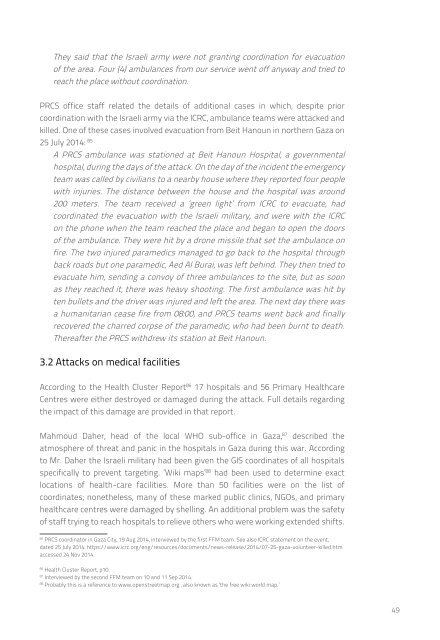HHo0s
HHo0s
HHo0s
Create successful ePaper yourself
Turn your PDF publications into a flip-book with our unique Google optimized e-Paper software.
They said that the Israeli army were not granting coordination for evacuationof the area. Four (4) ambulances from our service went off anyway and tried toreach the place without coordination.PRCS office staff related the details of additional cases in which, despite priorcoordination with the Israeli army via the ICRC, ambulance teams were attacked andkilled. One of these cases involved evacuation from Beit Hanoun in northern Gaza on25 July 2014: 85A PRCS ambulance was stationed at Beit Hanoun Hospital, a governmentalhospital, during the days of the attack. On the day of the incident the emergencyteam was called by civilians to a nearby house where they reported four peoplewith injuries. The distance between the house and the hospital was around200 meters. The team received a ‘green light’ from ICRC to evacuate, hadcoordinated the evacuation with the Israeli military, and were with the ICRCon the phone when the team reached the place and began to open the doorsof the ambulance. They were hit by a drone missile that set the ambulance onfire. The two injured paramedics managed to go back to the hospital throughback roads but one paramedic, Aed Al Burai, was left behind. They then tried toevacuate him, sending a convoy of three ambulances to the site, but as soonas they reached it, there was heavy shooting. The first ambulance was hit byten bullets and the driver was injured and left the area. The next day there wasa humanitarian cease fire from 08:00, and PRCS teams went back and finallyrecovered the charred corpse of the paramedic, who had been burnt to death.Thereafter the PRCS withdrew its station at Beit Hanoun.3.2 Attacks on medical facilitiesAccording to the Health Cluster Report 86 17 hospitals and 56 Primary HealthcareCentres were either destroyed or damaged during the attack. Full details regardingthe impact of this damage are provided in that report.Mahmoud Daher, head of the local WHO sub-office in Gaza, 87 described theatmosphere of threat and panic in the hospitals in Gaza during this war. Accordingto Mr. Daher the Israeli military had been given the GIS coordinates of all hospitalsspecifically to prevent targeting. ‘Wiki maps’ 88 had been used to determine exactlocations of health-care facilities. More than 50 facilities were on the list ofcoordinates; nonetheless, many of these marked public clinics, NGOs, and primaryhealthcare centres were damaged by shelling. An additional problem was the safetyof staff trying to reach hospitals to relieve others who were working extended shifts.85PRCS coordinator in Gaza City, 19 Aug 2014, interviewed by the first FFM team. See also ICRC statement on the event,dated 25 July 2014: https://www.icrc.org/eng/resources/documents/news-release/2014/07-25-gaza-volunteer-killed.htmaccessed 24 Nov 2014.86Health Cluster Report, p10.87Interviewed by the second FFM team on 10 and 11 Sep 2014.88Probably this is a reference to www.openstreetmap.org , also known as ‘the free wiki world map.’49


